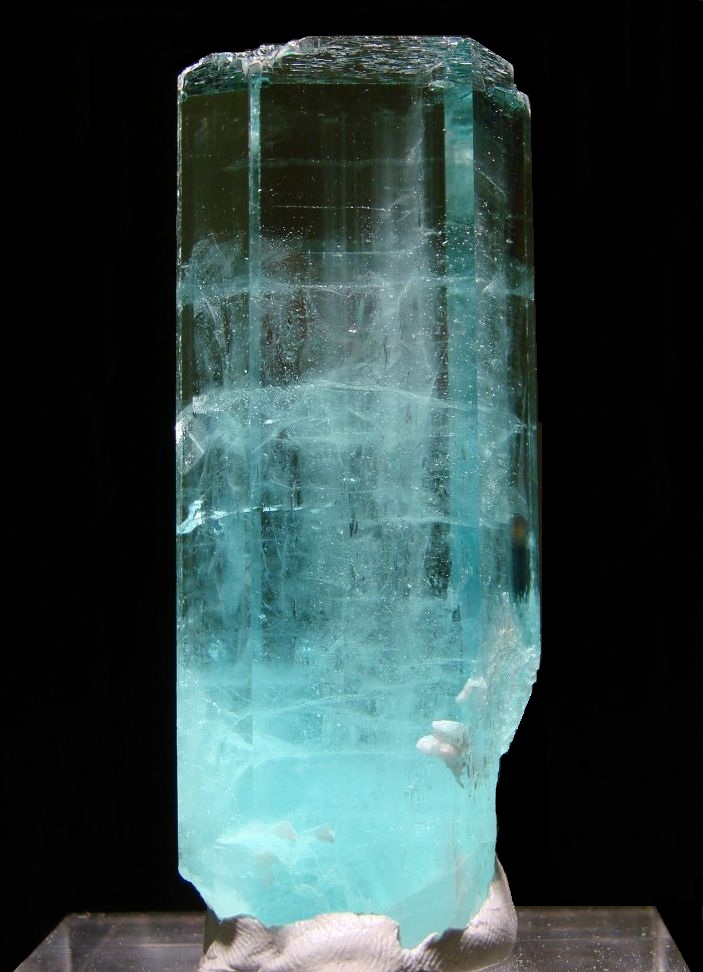
Straight-chain silicates are common in nature. The anionic or negative portion of the silicates consists of silicon and oxygen, sometimes in conjunction with metals Thus there are aluminosilicates, magnesium silicates, and ferrosilicates.
Sodium silicate, one of the most common examples, is simply, Na2SiO3.
In its anhydrous form, sodium silicate adopts a tetrahedrally-linked polymeric form.
Most silicates are not cyclic. Yet, the most beautiful silicates in the world – the most beautiful gemstones – are cyclosilicates.
Interestingly, it is the technological beauty of these silicates that has been turning heads. It may be that the most beautiful thing about cyclosilicates is their hole.
What Are Cyclosilicates?
Cyclosilicates have the same tetrahedral linkage as other silicates, but in their case, the chain ends close up to form rings.
There are three fairly common sizes of cyclosilicate rings. They are:
(Si3O9)
(Si4O12)
(Si6O18)
The rings are 3-membered, 4-membered, and 6-membered, respectively. In each of the structures the ratio of silicon to oxygen is 1:3.
Natural-Occurring Cyclosilicates
Beautiful natural gemstones belonging to the cyclosilicates include tourmaline, iolite, axinite, and the beryl cyclosilicates, which include emerald, aquamarine, heliodorus, Morganite, and Goshenite.
There are many less well-known cyclosilicates, however – this group includes: benitoite, dioptase, cordierite, hilairite, and jaoquinite. In fact, there are dozens more.
Beryl as Ore
Although some specimens of beryl are of gem or collector quality, much of it is used as ore for the production of the (unfortunately) poisonous metal beryllium, which is used in toughening metals, as “windows” in nuclear experiments, and in specialty ceramic substrates.
Zeolites
Zeolites are porous substances used as molecular sieves, and for purposes such as water purification. Other applications will doubtless follow.
The large channels in the structure of cyclosilicates such as beryl allow for the entrapment of water or carbon dioxide molecules and the substitution such as Fe+2 for Al+3 and Li+1 for Be+2. Alkali metal ions are incorporated in channels to make up for the loss of cationic charge.
In further developing zeolite-like properties, there have been studies such as that by Verlooy, et. al., in which hydrogen-bonded water and hexylethyleneimine molecules are flashed out of a new cyclosilicate structure, (C6H14N)4 · [Si8O16(OH)4] · 12H2O.
Quantum Paramagnetic Amplifier
The large vertical channels in cyclosilicates such as artificial emerald have made them useful in the design and function of devices called quantum paramagnetic amplifiers. These devices offer a very low noise factor. Another name by which these devices are called is the paramagnetic maser.
Similar to a laser, the “m” in maser stands for microwave, as versus the “l” standing for light in laser. One of the uses of the quantum paramagnetic amplifier lies in the field of radio astronomy. That field seeks to amplify incredibly weak incoming signals from distant objects in space, including microwave radiation.
Cyclosilicates: Useful Minerals
Tourmaline is used for its piezoelectric properties in the manufacture of pressure gauges and other electronic devices. Manufactured cyclosilicates are being developed for use as a resorbable, bio-active tissue engineering scaffold. With so much potential, these minerals are not just beautiful, they’re extremely useful as well.
Note: You might also enjoy Uranocene – the Trend Setting Aromatic Actinide Sandwich Compound
References:
- Akhumyan, A.: Quantum paramagnetic amplifier utilizing synthetic emerald crystals. (1979). Soviet Journal of Quantum Electronics
- Colgate University: Mineralogy: Cyclosilicates. (1997)
- MIT: Cyclosilicates. (2014)
- Chakoumakos, B, et al.: A molecular orbital study of rings in silicates and siloxane. (1981). American Mineralogist
- Nelson, S. Tulane University: Silicate Structures, Structural Formula, Neso-, Cyclo-, and Soro- Silicates. (2012). Tulane University
- Klyshko, D.: Physical Foundations of Quantum Electronics . (2011). World Scientific
- Verlooy, P, et al.: Synthesis and characterization of the new cyclosilicate hydrate (hexamethyleneimine)(4)center dot[Si8O16(OH)(4)]center dot 12H(2)O. (2010). Elsevier science bv

Crystals are beautiful. Some people keep large specimens for decoration.